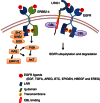LRIG1 is a triple threat: ERBB negative regulator, intestinal stem cell marker and tumour suppressor
- PMID: 23558895
- PMCID: PMC3658528
- DOI: 10.1038/bjc.2013.138
LRIG1 is a triple threat: ERBB negative regulator, intestinal stem cell marker and tumour suppressor
Abstract
In baseball parlance, a triple threat is a person who can run, hit and throw with aplomb. Leucine-rich repeats and immunoglobulin-like domains 1 (LRIG1) is a cell surface protein that antagonises ERBB receptor signalling by downregulating receptor levels. Over 10 years ago, Hedman et al postulated that LRIG1 might be a tumour suppressor. Recently, Powell et al provided in vivo evidence substantiating that claim by demonstrating that Lrig1 loss in mice leads to spontaneously arising, highly penetrant intestinal adenomas. Interestingly, Lrig1 also marks stem cells in the gut, suggesting a potential role for Lrig1 in maintaining intestinal epithelial homeostasis. In this review, we will discuss the ability of LRIG1 to act as a triple threat: pan-ERBB negative regulator, intestinal stem cell marker and tumour suppressor. We will summarise studies of LRIG1 expression in human cancers and discuss possible related roles for LRIG2 and LRIG3.
Figures



References
-
- Cai M, Han L, Chen R, Ye F, Wang B, Han F, Lei T, Guo D. Inhibition of LRIG3 gene expression via RNA interference modulates the proliferation, cell cycle, cell apoptosis, adhesion and invasion of glioblastoma cell (GL15) Cancer Lett. 2009;278:104–112. - PubMed
-
- Ghasimi S, Haapasalo H, Eray M, Korhonen K, Brannstrom T, Hedman H, Andersson U. Immunohistochemical analysis of LRIG proteins in meningiomas: correlation between estrogen receptor status and LRIG expression. J Neurooncol. 2012;108:435–441. - PubMed
Publication types
MeSH terms
Substances
Grants and funding
LinkOut - more resources
Full Text Sources
Other Literature Sources
Medical
Molecular Biology Databases
Research Materials
Miscellaneous

